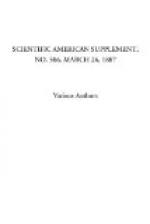Next the operator moves along the side of the boat the sharpened end, s_{1}, of the rod, E, and thus for the curve from keel to gunwale, s_{2} describes a construction line. It is at once evident that a_{2}, for example, corresponds to the point, a_{1}. The apparatus is now removed and placed on the working floor. If, reversing things, the point, s_{1}, is carried around the construction curve, the point, s_{2}, will inscribe the desired section in its natural dimensions. This operation is best conducted after one has chosen and described all the construction curves of the boat. Next, the different section lines are determined, one by one, by the reversed method above described. The result is a half section of the boat; the other symmetrical half is easily obtained.
If the whole process is repeated for the other side of the boat, tracing paper being used instead of drawing paper, the boat may be tested for symmetry of building, a good control for the value of the ship. For measuring boats, as for clubs and regattas, for seamen, and often for the so-called Spranzen (copying) of English models, my apparatus, I doubt not, will be very useful.—Neuste Erfindungen und Erfahrungen.
* * * * *
TAR FOR FIRING RETORTS.
The attention of gas engineers has been forcibly directed to the use of tar as a fuel for the firing of retorts, now that this once high-priced material is suffering, like everything else (but, perhaps, to a more marked extent), by what is called “depression in trade.” In fact, it has in many places reached so low a commercial value that it is profitable to burn it as a fuel. Happily, this is not the case at Nottingham; and our interest in tar as a fuel is more experimental, in view of what may happen if a further fall in tar products sets in. I have abandoned the use of steam injection for our experimental tar fires in favor of another system. The steam injectors produce excellent heats, but are rather intermittent in their action, and the steam they require is a serious item, and not always available.
[Illustration]
Tar being a pseudo liquid fuel, in arranging for its combustion one has to provide for the 20 to 25 per cent. of solid carbon which it contains, and which is deposited in the furnace as a kind of coke or breeze on the distillation of the volatile portions, which are much more easily consumed than the tar coke.
THE TAR FIRE
I have adopted is one that can be readily adapted to an ordinary coke furnace, and be as readily removed, leaving the furnace as before. The diagram conveys some idea of the method adopted. An iron frame, d, standing on legs on the floor just in front of the furnace door, carries three fire tiles on iron bearers. The top one, a, is not moved, and serves to shield the upper face of the tile, b, from the




